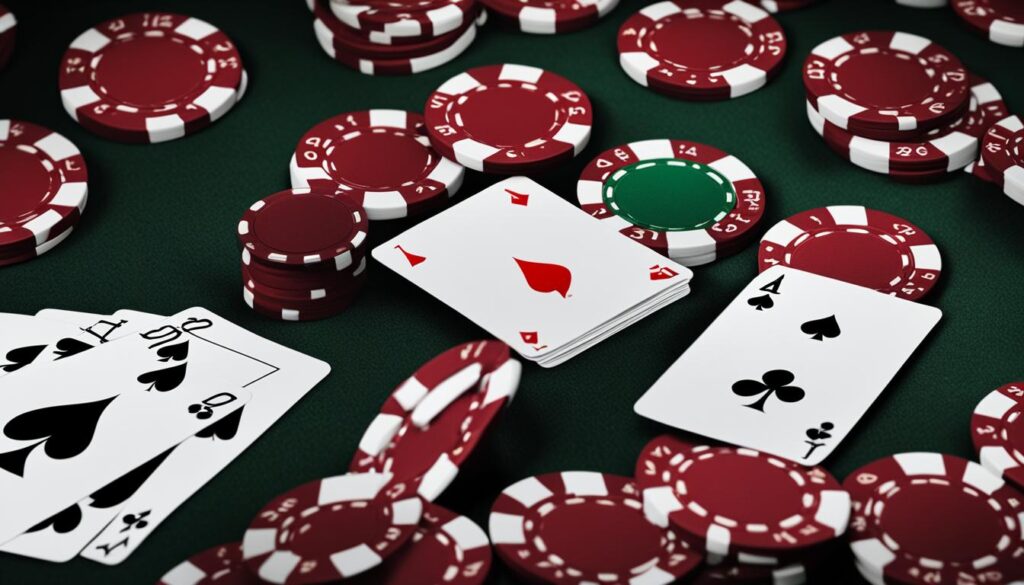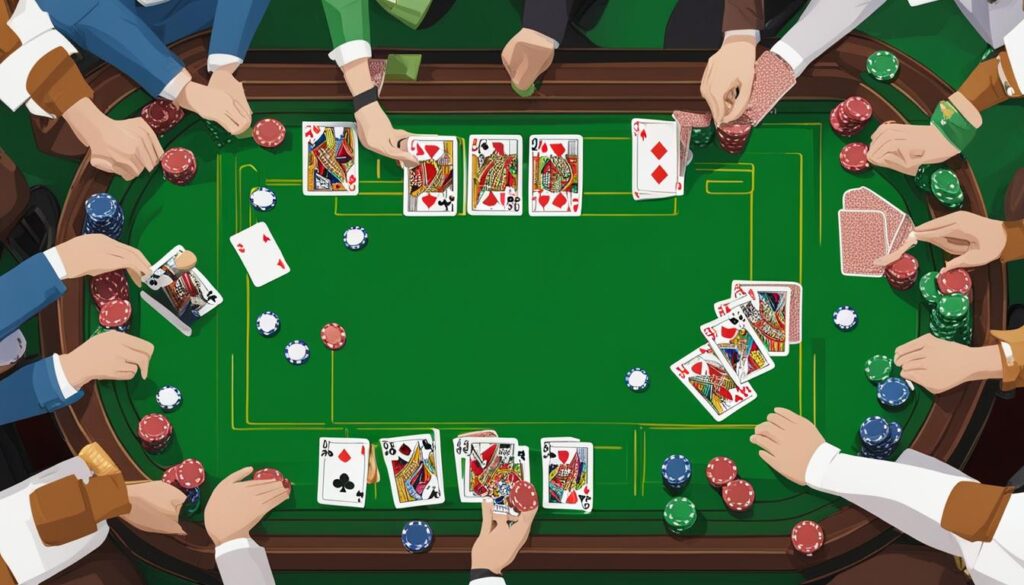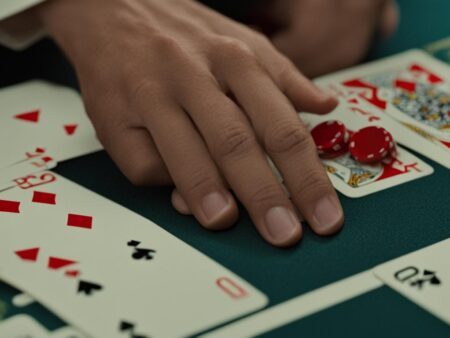Welcome to our expert guide on understanding how much aces are worth in blackjack. Aces are unique cards in the game, and their value can greatly impact a player’s strategy and chances of winning. In this article, we will explore the value of aces in blackjack, when to count them as 1 or 11, and strategies for playing ace hands effectively.
Key Takeaways:
- The value of an ace in blackjack can be either 1 or 11 points.
- Aces allow players to adapt their strategy based on the situation.
- Understanding the value of aces is crucial for determining the total value of your hand.
- Players should consider the value of their hand and the likelihood of going over 21 when deciding how to count their ace.
- Advanced strategies for maximizing the ace’s value can improve the player’s chances of winning.
The Basics of Card Values in Blackjack
In blackjack, understanding the values of different cards is essential for making informed decisions during gameplay. Each card holds a specific value, and knowing these values will help players determine the total value of their hand.
In blackjack, numbered cards are worth their pip value. For example, a 2 of hearts is worth 2 points, a 5 of clubs is worth 5 points, and so on. Face cards, which include the jack, queen, and king, are all worth 10 points each. These cards provide a fixed value and can greatly impact the total value of a player’s hand.
The most unique card in blackjack is the ace. An ace can be valued as either 1 or 11 points, depending on the player’s preference and the rest of the cards in their hand. This flexibility is what makes the ace such a valuable card in blackjack. It allows players to adapt their strategy based on the situation at hand, whether they need a higher or lower total to win.
Understanding the basic card values in blackjack is crucial for developing a successful playing strategy. By knowing the values of each card, players can make informed decisions, maximize their hand’s value, and increase their chances of winning.
The Ace’s Unique Value in Blackjack
In the game of blackjack, the ace holds a special place. Its unique value allows players to adapt their strategy based on the situation. The power of the ace lies in its flexibility – it can be valued as either 1 or 11, depending on the player’s hand. This flexibility offers players numerous advantages and opportunities to improve their chances of winning.
When an ace is valued as 11, it can help players reach a higher total without going over 21, commonly referred to as a “soft hand.” This can be especially beneficial when players have a hand that needs improvement. By hitting or doubling down, players can draw additional cards with the goal of achieving a stronger hand. The ace’s value of 11 provides players with the confidence to take risks and pursue a more favorable outcome.
On the other hand, when an ace is valued as 1, players have a “hard hand.” This means that the total value of their hand is less than 11, and hitting can result in going over 21. In these situations, players often choose to stand and play more cautiously, as hitting may put them at risk of busting. By valuing the ace as 1, players exercise caution and aim to secure a winning hand without taking unnecessary risks.
The flexibility of the ace allows players to adapt their strategy, maximize their chances of winning, and minimize the house’s edge.
In summary, the ace’s unique value in blackjack is its ability to be counted as either 1 or 11 points. This flexibility empowers players to make strategic decisions based on the current state of their hand. Whether it’s aiming for a higher total or playing it safe, the power of the ace lies in its ability to shape the outcome of the game. Understanding how to leverage the ace’s value is key to mastering the game of blackjack.
When an Ace Counts as 1 vs. 11

In the game of blackjack, the value of an ace can vary depending on the player’s hand and the total value they are aiming for. Understanding when an ace counts as 1 or 11 is crucial for making strategic decisions during gameplay.
When a player’s hand would go over 21 if the ace were counted as 11, the ace is automatically valued as 1 to prevent the player from busting. For example, if a player has a hand with an ace and a 9, counting the ace as 11 would give them a total of 20. But if they were to draw another card and get an 8, their hand would exceed 21. In this case, the ace is valued as 1, giving them a total of 18.
On the other hand, if a player’s hand is 11 or less, the ace is always counted as 11. For instance, if a player has an ace and a 6, counting the ace as 1 would give them a total of 7, which is not advantageous. But by counting the ace as 11, they have a total of 17, which puts them in a better position to potentially win the hand.
Knowing when to count an ace as 1 or 11 requires careful consideration of the player’s current hand value and their desired total. Players must weigh the risks and rewards to determine the best course of action. This decision-making process is an essential part of the strategic gameplay that makes blackjack such a thrilling and intellectually stimulating casino game.
How to Play an Ace Hand in Blackjack

When playing blackjack, one of the most crucial decisions a player faces is how to play an ace hand. With the unique value of aces, players have the opportunity to adapt their strategy based on the value of their hand and the dealer’s upcard. To make the most of an ace hand, players should consider the following strategies:
Soft Hand (Ace Counted as 11)
When dealt an ace that is counted as 11, players have the advantage of having a “soft” hand. This means that even if they draw additional cards that would normally bust their hand, they can always change the value of the ace to 1 point, avoiding a bust. With a soft hand, players can confidently double down and hit for more cards, knowing that they can adjust the value of the ace if necessary. This strategy allows players to maximize their chances of reaching a higher total and potentially beat the dealer’s hand.
Hard Hand (Ace Counted as 1)
If the ace in a player’s hand is counted as 1 point, they have a “hard” hand. In this scenario, players should play more cautiously and consider standing if their total is 12 or higher. Standing with a hard hand can help minimize the risk of busting and increase the chances of winning the hand. However, if the dealer’s upcard is weak (2-6), players may choose to hit for another card to try to improve their hand and beat the dealer’s total. It’s important to remember that with a hard hand, the value of the ace cannot be changed to 11, so players must carefully consider their options.
Splitting a Pair of Aces
When dealt a pair of aces, players have the option to split them into two separate hands. This strategy is highly recommended, as it gives players two chances at hitting blackjack and increases their overall chances of winning. By splitting a pair of aces, players start each hand with a solid foundation, making it easier to reach a favorable total. It’s important to note that some casinos have specific rules regarding splitting aces, so players should familiarize themselves with the rules of the casino they’re playing at.
Overall, playing an ace hand in blackjack requires careful consideration and strategic decision-making. By understanding the value of aces and implementing the appropriate strategies based on the value of the hand and the dealer’s upcard, players can increase their chances of winning and achieve a profitable outcome.
Advanced Strategies for Maximizing the Ace’s Value
When it comes to maximizing the value of an ace in blackjack, there are a few advanced strategies that players can employ. By utilizing these strategies, players can increase their chances of winning and improve their overall gameplay. Let’s take a closer look at some of these strategies:
Strategy 1: Memorizing Basic Strategy Guides
One of the most effective ways to maximize the value of an ace in blackjack is by memorizing basic strategy guides. These guides provide players with a set of rules and actions to take based on the value of their hand and the dealer’s upcard. By following these guides, players can make more informed decisions when it comes to counting their ace as either 1 or 11. This strategy helps players minimize losses and increase their chances of reaching a winning hand.
Strategy 2: Knowing When to Split Aces
Another advanced strategy for maximizing the value of an ace is knowing when to split aces. When a player is dealt two aces, it is always recommended to split them into two separate hands. By doing this, players have the opportunity to potentially form two strong hands and increase their chances of hitting blackjack. Splitting a pair of aces is a strategy that can help players maximize their profits and gain an advantage over the dealer.
By employing these advanced strategies for maximizing the value of an ace in blackjack, players can take their gameplay to the next level. Memorizing basic strategy guides and knowing when to split aces can greatly improve a player’s chances of winning and minimize the house’s edge. Understanding the unique power of the ace and how to strategically utilize it is key to becoming a successful blackjack player.
Splitting Cards in Blackjack: A Strategic Move
In the exciting game of blackjack, players have the strategic option to split cards when they are dealt a pair of the same value. Splitting cards can significantly increase a player’s chances of winning, as it allows them to form two separate hands and play each hand independently. Let’s explore how splitting cards work in blackjack and the benefits it can offer players.
When a player decides to split cards, they must place an additional bet equal to their original wager. The dealer then separates the pair of cards, forming two individual hands. The player will receive an additional card for each hand, effectively creating two new starting hands.
Splitting cards is particularly advantageous when it comes to pairs of aces. By splitting a pair of aces, players can maximize their chances of hitting blackjack, as they now have two opportunities to draw a card with a value of 10. This not only increases their chances of winning but also gives them the potential for a higher payout.
It’s important to note that not all pairs are recommended for splitting. Generally, pairs of 10s, face cards, or 5s should not be split, as they already hold a strong value. On the other hand, pairs of 2s, 3s, 6s, 7s, and 9s can be split against certain dealer upcards. Consulting a basic blackjack strategy chart can help players determine when it is favorable to split their cards and make the most of their hand.
The Advantages of Splitting Cards
Splitting cards in blackjack offers several advantages. Firstly, it allows players to turn one potentially weak hand into two potentially strong hands. This can be especially beneficial when the dealer has a weak upcard, as it gives players a better chance of surpassing the dealer’s hand.
Additionally, splitting cards can help players manage risk and minimize losses. For example, if a player is dealt a pair of 8s and decides to split them, they now have two hands with a value of 8 each. This ensures that even if one hand busts, the player still has a chance to win with the other hand.
Furthermore, splitting cards can give players the opportunity to apply different strategies to each hand. This flexibility allows them to adapt their gameplay based on the specific circumstances of each hand, potentially increasing their overall success.
Summary
Splitting cards in blackjack is a powerful move that can enhance a player’s chances of winning. By strategically splitting pairs, players can create two separate hands, increase their chances of hitting blackjack, and adapt their strategy based on each individual hand. However, it is important to follow basic blackjack strategy guidelines and consider the dealer’s upcard when deciding whether to split cards. With careful decision-making and a bit of luck, splitting cards can be a valuable technique in a player’s blackjack arsenal.
How Much Are Aces Worth in Blackjack?
Aces in blackjack can be worth either 1 or 11, depending on the value of the player’s hand. They are valuable cards, as they can help players reach a total of 21 and increase their chances of winning.
When a player is dealt an ace, they have the flexibility to choose its value based on their hand. For example, if a player has an ace and a 7, they can choose to count the ace as 11, resulting in a total hand value of 18. On the other hand, if a player has an ace, a 5, and a 10, counting the ace as 11 would result in a bust as the total hand value would exceed 21. In this case, the player would choose to count the ace as 1, giving them a total hand value of 16.
The value of aces in blackjack allows players to adapt their strategy and make decisions that best suit their current situation. It is important for players to consider the other cards in their hand, the dealer’s upcard, and the likelihood of going over 21 when deciding how to play their aces. By understanding the worth of aces and utilizing them strategically, players can increase their chances of success at the blackjack table.
In summary, aces in blackjack have a unique value and can be worth either 1 or 11. They are valuable cards that provide players with flexibility in reaching a total of 21 and increasing their chances of winning. By carefully considering the value of aces in relation to the rest of their hand and the dealer’s upcard, players can make informed decisions and maximize their potential for success at the blackjack table.
How to Play Aces in Blackjack
When playing blackjack, aces are incredibly valuable cards that can greatly influence the outcome of a hand. As mentioned earlier, aces can be counted as either 1 or 11, depending on the player’s preference and the other cards in their hand. Strategically playing aces can give players a significant advantage and increase their chances of winning.
When you are dealt an ace in blackjack, it’s important to consider the other cards in your hand and the likelihood of going over 21. If your hand already totals 11 or less, it’s recommended to count the ace as 11 to give yourself the opportunity to reach a higher total. However, if your hand is already close to 21 or has a high risk of going over, it’s better to count the ace as 1 to minimize the risk of busting.
Additionally, when playing multiple decks of cards, it’s essential to pay attention to whether or not the dealer must stand or hit on a soft 17. This can impact your decision-making when it comes to playing aces. If the dealer must hit on a soft 17, it’s generally more advantageous for players to count their aces as 1 to reduce the chances of the dealer improving their hand.
Strategies for Playing Aces in Blackjack
- If you have a soft hand (ace counted as 11), consider doubling down when the dealer has a weak upcard. This can help maximize your potential winnings.
- With a hard hand (ace counted as 1), play more cautiously and consider standing when you have a higher total. Remember, the dealer must hit on a hand totaling 16 or less, so playing defensively can be beneficial.
- If you are dealt a pair of aces, always split them. Splitting aces gives you two separate hands and increases your chances of hitting blackjack or forming strong hands.
By following these strategies, you can effectively play aces in blackjack and optimize your chances of winning. Remember, blackjack is a game of skill, so it’s important to make informed decisions based on the cards you are dealt and the dealer’s upcard.
| Hand | Recommended Action |
|---|---|
| A, A | Always split |
| A, 2 to A, 9 | Double down against dealer’s 5 or 6, otherwise, hit |
| A, 10 | Count as 21, do not hit |
| A, A, 2 or A, A, 3 | Split against dealer’s 5 or 6, otherwise, hit |
| A, A, 4 or A, A, 5 | Split against dealer’s 4, 5, or 6, otherwise, hit |
| A, A, 6 | Split against dealer’s 3, 4, 5, or 6, otherwise, hit |
| A, A, 7 | Always split |
| A, A, 8 or A, A, 9 | Always split |
| A, A, 10 | Count as 21, do not hit |
Playing aces strategically can significantly improve your success rate in blackjack. By understanding when to hit, stand, double down, or split with aces, you can make more informed decisions and increase your chances of beating the dealer.
What Happens When a Player Has Two Aces?
When a player is dealt two aces in a game of blackjack, it is always advisable to split them. Splitting aces gives the player two separate hands to play, each starting with an ace. This strategy increases the player’s chances of hitting blackjack, which is the best possible hand in the game, and improves their overall odds of winning against the dealer.
By splitting the aces, the player has the opportunity to build two strong hands, with the potential to reach a total of 21 in each hand. It also ensures that they will not bust (go over a total of 21) on the first hit, as the ace can be counted as either 1 or 11 depending on the other card values. Splitting aces is a widely accepted and recommended strategy among blackjack players.
It is important to note that when a player splits their aces, they will receive only one additional card for each hand. The option to hit, stand, or double down will then apply separately to each hand. While splitting aces gives the player a greater chance of winning, there is still some risk involved as the outcome of each hand will depend on the subsequent cards dealt.
| Player’s Hand | Recommended Action |
|---|---|
| Two Aces | Split |
| Ace and a Ten-Value Card | Blackjack! Collect winnings |
| Ace and a Low Card | Hit for additional card |
| Ace and a High Card | Stand, play cautiously |
Overall, when a player is dealt two aces in blackjack, they should always split them to maximize their chances of winning. This strategy offers the potential to form two strong hands and potentially hit blackjack, the best hand in the game. Splitting aces is a fundamental and effective strategy that should be employed by blackjack players whenever possible.
What Happens If the Dealer Has Two Aces?
In blackjack, the dealer plays a crucial role in determining the outcome of the game. When it comes to the value of aces, the dealer’s hand follows specific rules. If the dealer has two aces in their hand, the second ace and any subsequent aces will always be worth 1 point. This rule ensures that the dealer does not gain an unfair advantage by having multiple aces in their hand.
The value of the dealer’s aces can have an impact on the player’s strategy. Knowing that the dealer’s second ace will be worth 1 point can influence the player’s decisions, especially when it comes to hitting or standing. It’s important for players to consider the possibility of the dealer having multiple aces and adjust their gameplay accordingly.
When facing a dealer with two aces, players should also remember the importance of their own hand’s value. If their hand is strong and close to 21, they can continue playing strategically based on their own cards. However, if their hand is weak, it may be more advantageous for the player to surrender or take other strategic actions to minimize potential losses.
| Player’s Hand Value | Recommended Action |
|---|---|
| Close to 21 | Continue playing strategically based on own cards |
| Weak or likely to bust | Surrender or take other strategic actions to minimize losses |
Overall, understanding how the dealer’s aces are valued can help players make informed decisions in blackjack. By considering both their own hand and the dealer’s potential hand, players can maximize their chances of winning and minimize potential losses in the game.
Can You Split Aces Twice in Blackjack?
In most cases, players can only split aces once in blackjack. This means that if you decide to split a pair of aces, you will receive one additional card for each ace, and then you will have to stand with your two separate hands. However, there are some variations of blackjack where players are allowed to split aces twice.
Splitting aces twice can potentially give you even more opportunities to improve your hands and increase your chances of winning. It allows you to create up to four separate hands from a single pair of aces. This can be particularly advantageous if you receive another ace in one of the split hands, as it can be split again.
It’s important to note that not all casinos or blackjack variations will allow you to split aces twice. Before playing, make sure to familiarize yourself with the specific rules of the game and check if the casino you’re playing at allows this option. Splitting aces twice can be a strategic move in certain situations, so it’s worth considering if you want to maximize your chances of success at the blackjack table.
Table: Rules for Splitting Aces in Blackjack
| Blackjack Variation | Splitting Aces Twice Allowed? |
|---|---|
| Standard Blackjack | No |
| European Blackjack | No |
| Spanish 21 | Yes |
| Double Exposure Blackjack | Yes |
| Blackjack Switch | Yes |
Conclusion
In conclusion, aces in blackjack are highly valuable cards that can greatly impact a player’s chances of winning. Their unique flexibility allows players to adapt their strategy based on the current situation and the rest of the cards in their hand. Understanding the value of aces and how to play them strategically is essential for maximizing success in the game.
When playing with a soft hand (ace counted as 11), players have the advantage of being able to double down and hit for more cards, increasing their chances of reaching a higher total. However, with a hard hand (ace counted as 1), players should exercise caution and consider standing to avoid going over the desired total.
Advanced strategies for maximizing the value of aces in blackjack include memorizing basic strategy guides and knowing when to split aces. Splitting a pair of aces gives players two chances at hitting blackjack and significantly increases their chances of winning against the dealer.
Overall, aces in blackjack are powerful cards that can make or break a player’s hand. By understanding their unique value and employing effective strategies, players can enhance their gameplay and increase their chances of success at the blackjack table.
References
As experts in the field of blackjack, we have relied on various reputable sources to gather information for this article. If you’re looking to expand your knowledge on aces in blackjack or delve deeper into the strategies mentioned, we highly recommend consulting the following references:
1. “Blackjack: Play Like the Pros” by John Bukofsky – This comprehensive book offers valuable insights into the game, including tips and strategies for playing aces in blackjack. It is a must-read for both beginners and experienced players.
2. “Beat the Dealer: A Winning Strategy for the Game of Twenty-One” by Edward O. Thorp – Considered a classic in the world of blackjack, this book provides a mathematical approach to the game. It covers the value of aces and offers strategies for maximizing their potential.
3. “The World’s Greatest Blackjack Book” by Lance Humble and Carl Cooper – This resource covers various aspects of blackjack, including the value and play of aces. It offers practical advice and techniques that can be applied to improve your gameplay.
By consulting these references, you will gain a deeper understanding of aces in blackjack, enhancing your ability to make informed decisions and potentially increase your chances of success at the table.
FAQ
How much are aces worth in blackjack?
Aces in blackjack can be worth either 1 or 11, depending on the value of the player’s hand.
What are the basic card values in blackjack?
Numbered cards are worth their pip value, face cards are worth 10 points each, and aces can be worth 1 or 11 points.
Why are aces unique and powerful in blackjack?
Aces in blackjack can be valued as either 1 or 11, giving players flexibility in reaching a higher total and adapting their strategy based on the situation.
When does an ace count as 1 vs. 11?
If a player’s hand would go over 21 by counting the ace as 11, the ace becomes worth 1 point. However, if the hand’s total is 11 or less, the ace is always counted as 11.
How should I play an ace hand in blackjack?
With a soft hand (ace counted as 11), players can double down and hit for more cards. With a hard hand (ace counted as 1), players should play more cautiously and consider standing.
Are there advanced strategies for maximizing the ace’s value in blackjack?
Yes, advanced strategies include memorizing basic strategy guides and understanding when to split aces.
What does splitting cards mean in blackjack?
Splitting cards refers to the option of separating two cards of the same value into two separate hands, increasing the player’s chances of winning.
How much are aces worth in blackjack?
Aces in blackjack can be worth either 1 or 11, depending on the value of the player’s hand.
How should I play aces in blackjack?
Players should consider the other cards in their hand and the likelihood of going over 21 when deciding how to play their aces.
What should a player do when they have two aces in blackjack?
Players should always choose to split their two aces, as it increases their chances of hitting blackjack and winning against the dealer.
What happens if the dealer has two aces in blackjack?
The second ace and any subsequent aces held by the dealer will be worth 1 point, to prevent the dealer from having an advantage with multiple aces.
Can you split aces twice in blackjack?
In most cases, players can only split aces once in blackjack. However, specific casino rules may allow players to split aces twice.
Where can I find more information about aces in blackjack?
For additional information and resources about blackjack, refer to the references and sources provided at the end of this article.







